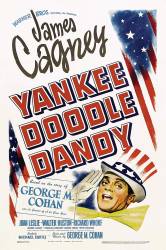Factual error: Although quite typical for biopics of this era, certain aspects of Cohan's life are glossed over. The movie shows him in a lifelong marriage to his first love. However, he was in fact married in 1899 to Ethel Levy, and after their divorce in 1907 he married Agnes Mary Nolan, who remained his wife until Cohan's death in 1942.
Factual error: The newspaper headline about the sinking of the Lusitania has a photograph of the ship with only two funnels. The Lusitania had four.
Factual error: In the movie, Cohan's play Popularity, the sinking of the Lusitania, and America's entry into WWI are depicted as occurring in rapid succession. However, Popularity was on the stage in 1906, the Lusitania was sunk in 1915, and America entered the war in 1917.
Factual error: In the scene from the play, "George Washington, Jr.," a troop of boy scouts is shown on stage. The play opened in 1906, but the boy scout movement was started in 1908 in the UK, and the Boy Scouts of America did not exist until 1910.
Factual error: George tap dances down the stairs after visiting the President in the Oval Office. But the Oval Office is on the ground floor of the White House.
Factual error: At the end of the movie, Cohan is shown performing in "I'd Rather be Right," which was a real play. However, one of the lines in the performance is "and now they've taken France." The play ran on Broadway in 1937, but Germany did not invade France until 1940.
Factual error: The movie has Roosevelt presenting Cohan with the Congressional Medal of Honor. Cohan was actually presented the Congressional Gold Medal, which is the nation's highest civilian award. The Medal of Honor is the highest military decoration, awarded for heroism above and beyond the call of duty in combat.





